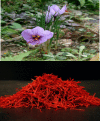Razi's Al-Hawi and saffron (Crocus sativus): a review
- PMID: 26877844
- PMCID: PMC4744354
Razi's Al-Hawi and saffron (Crocus sativus): a review
Abstract
Traditional knowledge can be used as a source for development of new medicines. In the present study, we compare the data on saffron in Razi's Al-Hawi book with modern scientific studies. A computerized search of published articles was performed using MEDLINE, Scopus as well as native references. The search terms used were saffron, Crocus sativus, crocetin, crocin, safranal, Razi, and Al-Hawi. A variety of properties of saffron including diuretic, analgesic, anti-inflammatory, hepatoprotective, appetite suppressant, hypnotic, antidepressant, and bronchodilator effects were mentioned in Al-Hawi. Modern studies also confirmed most of these characteristics. This review indicates that the pharmacological data on saffron and its constituents are similar to those found in Razi's Al-Hawi monograph and it can be concluded that ethnobotanical information and ancient sources have precious data about medicinal plants that lead to finding new compounds for treatment of several diseases.
Keywords: Al-Hawi; Crocin; Crocus sativus L; Razi; Saffron; Safranal; Traditional medicine.
Figures
Similar articles
-
Avicenna's (Ibn Sina) the Canon of Medicine and saffron (Crocus sativus): a review.Phytother Res. 2013 Apr;27(4):475-83. doi: 10.1002/ptr.4784. Epub 2012 Jul 20. Phytother Res. 2013. PMID: 22815242 Review.
-
Active constituents of saffron (Crocus sativus L.) and their prospects in treating neurodegenerative diseases (Review).Exp Ther Med. 2023 Apr 3;25(5):235. doi: 10.3892/etm.2023.11934. eCollection 2023 May. Exp Ther Med. 2023. PMID: 37114174 Free PMC article. Review.
-
Immunoregulatory and anti-inflammatory properties of Crocus sativus (Saffron) and its main active constituents: A review.Iran J Basic Med Sci. 2019 Apr;22(4):334-344. doi: 10.22038/ijbms.2019.34365.8158. Iran J Basic Med Sci. 2019. PMID: 31223464 Free PMC article. Review.
-
Interaction of saffron and its constituents with Nrf2 signaling pathway: A review.Iran J Basic Med Sci. 2022 Jul;25(7):789-798. doi: 10.22038/IJBMS.2022.61986.13719. Iran J Basic Med Sci. 2022. PMID: 36033950 Free PMC article. Review.
-
A review of therapeutic impacts of saffron (Crocus sativus L.) and its constituents.Physiol Rep. 2023 Aug;11(15):e15785. doi: 10.14814/phy2.15785. Physiol Rep. 2023. PMID: 37537722 Free PMC article. Review.
Cited by
-
Edible Herbal Medicines as an Alternative to Common Medication for Sleep Disorders: A Review Article.Curr Neuropharmacol. 2024;22(7):1205-1232. doi: 10.2174/1570159X21666230621143944. Curr Neuropharmacol. 2024. PMID: 37345244 Free PMC article. Review.
-
Isolation, purification and characterization of naturally derived Crocetin beta-d-glucosyl ester from Crocus sativus L. against breast cancer and its binding chemistry with ER-alpha/HDAC2.Saudi J Biol Sci. 2020 Mar;27(3):975-984. doi: 10.1016/j.sjbs.2020.01.018. Epub 2020 Jan 27. Saudi J Biol Sci. 2020. PMID: 32127777 Free PMC article.
-
Functional, Nutraceutical and Health Endorsing Perspectives of Saffron.Food Sci Nutr. 2025 Aug 6;13(8):e70721. doi: 10.1002/fsn3.70721. eCollection 2025 Aug. Food Sci Nutr. 2025. PMID: 40772023 Free PMC article. Review.
-
Medicinal Plants Used for Anxiety, Depression, or Stress Treatment: An Update.Molecules. 2022 Sep 15;27(18):6021. doi: 10.3390/molecules27186021. Molecules. 2022. PMID: 36144755 Free PMC article. Review.
-
Fractional Exhalation Nitric Oxide (FeNO) changes in cystic fibrosis patients induced by compound honey syrup: a pretest-posttest clinical trial.BMC Pulm Med. 2023 Dec 5;23(1):488. doi: 10.1186/s12890-023-02787-9. BMC Pulm Med. 2023. PMID: 38053097 Free PMC article. Clinical Trial.
References
-
- Fallah M. Introduction to the Traditional Medicine. http://iran-med.ir/?PageID=5 .
-
- Najmabadi M. International Institute of Iranian Traditional Medicine Mud. http://maadteb.com/history-of-medicine/
-
- Tadjbakhsh H. History of Veterinary Medicine in Medicine of Iran. Vol. 2. Tehran: University Publications; 2001. pp. 284–292.
-
- Najmabadi M. Mohammad ibn Zakarya Razi, Iranian Physician, Chemist and Philosopher (in Persian) Tehran: Razi University Publications; 1992.
-
- Safa Z. History of Rational Sciences in lslamic Civilization. Vol. 1. Tehran: University Publications (in Persian); 1997. pp. 165–179.
Publication types
LinkOut - more resources
Full Text Sources



